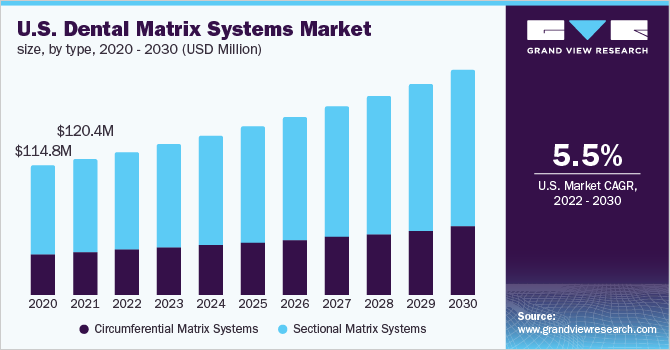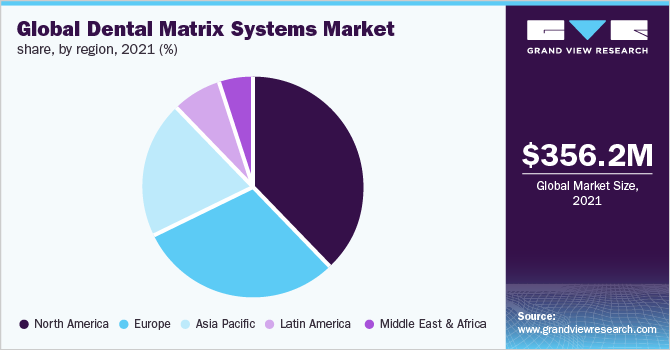- Home
- »
- Medical Devices
- »
-
Dental Matrix Systems Market Size & Growth Report, 2030GVR Report cover
![Dental Matrix Systems Market Size, Share & Trends Report]()
Dental Matrix Systems Market Size, Share & Trends Analysis Report By Type (Circumferential Matrix Systems, Sectional Matrix Systems), By End Use, By Region, And Segments Forecasts, 2022 - 2030
- Report ID: GVR-4-68039-943-8
- Number of Report Pages: 100
- Format: PDF, Horizon Databook
- Historical Range: 2018 - 2020
- Forecast Period: 2022 - 2030
- Industry: Healthcare
Report Overview
The global dental matrix systems market size was valued at USD 356.2 million in 2021 and is expected to expand at a compound annual growth rate (CAGR) of 5.8% from 2022 to 2030. The market is estimated to grow at a significant pace in the coming years due to the growing demand for restorative dentistry. In addition to this, rising dental tourism in emerging economies is contributing to the growth of the market. There has been a wide increase in technologically advanced products and solutions in the field of dentistry across the globe. These advancements are expected to raise the effectiveness of the services in the dentistry vertical.

Furthermore, people across the world are becoming more conscious related to oral health problems in their routine life. There has been a significant rise in the incidences of oral diseases. These oral health issues are leading to the increased demand for effective healthcare facilities. This is expected to boost the expansion opportunities in the market in the years to come. The growing prevalence of dental caries and tooth decay across the globe is expected to fuel the demand for dental treatment. The rising demand for restorative and cosmetic dentistry is also anticipated to drive the demand for dental matrix systems.
Regular dental checkups and visits may raise the demand for dental treatments and procedures. According to the U.S. Centers for Disease Control and Prevention (CDC), around 84.9% of children aged between 2 and 17 years, nearly 64.0% of adults from 18 to 64 years of age, and nearly 65.6% of adults aged 65 and above have had at least one visit to a dentist. The routine checkups mainly include crowns, root canals, maxillofacial procedures, bonding treatments, and fillings. Thus, regular dental checkups are anticipated to fuel the growth of the market.
The Covid -19 has affected all the markets including the medical industry as there was a complete lockdown imposed by the government all over the world. The supply chain of dental matrix systems was also affected. The pandemic has caused a significant disruption in the supply chain of the overall medical device industry. The outbreak of coronavirus has impacted the market negatively as there was a decline in the number of procedures in 2020 and 2021 due to global restrictions. However, this is estimated to be a temporary effect and during the forecast period, the demand for dental matrix systems is likely to increase post-pandemic. An increase in awareness regarding dental care and rising oral problems will drive the market.
Type Insights
The sectional dental matrix systems segment dominated the market in 2021 with a revenue share of over 65.0%. This is due to the fact that sectional matrix techniques offer more predictable solutions to achieve contact areas. The sectional matrix is the highly adopted way of achieving a strong contact point in Class II restorations in the posterior sector with composite resin.
In the sectional matrix system, each tooth is parted into different segments with a matrix band that can be detached similar to detaching the rubber bands. This sectional matrix system is used for the purpose of reducing soft tissue swelling and maximizing implant exposure. Therefore, the sectional dental matrix systems are preferred by most dentists. Sectional matrix systems for composite restorations are on a rise nowadays. Sectional matrices do not only result in tighter anatomical contacts but also are dentist friendly.
End-use Insights
The hospitals and dental clinics segment accounted for the largest revenue share of over 60.0% in 2021. The growing number of dental clinics across the globe and the wide adoption of cosmetic dentistry by small and large dental clinics are the major factors driving the segment. The rising number of clinics, especially in well-developed countries, is also expected to boost the growth of the segment. Dentists in developed countries are well compensated for their services and treatments because of public healthcare, depending on location.
Furthermore, the rising enrollment in dental courses is driving this end-use segment. For instance, according to the NCBI, in India, in 2019, 2.7 lakh are registered with the Dental Council of India (DCI). The growing number of dental clinics and hospitals and the higher number of dental freshers passed out per year are likely to drive this segment.
Regional Insights
North America dominated the market with a revenue share of over 35.0% in 2021 and is expected to register a significant CAGR in the forecast period. This is due to the increased reimbursement for dental services and the growing number of dental problems among children and adults. Europe held the second-largest revenue share in 2021 due to technological advancements and the increasing number of service providers.

The APAC region is expected to register the highest CAGR of 6.9% over the forecast period owing to favorable government initiatives, a large population, and the availability of developed healthcare facilities in these countries. Populated countries like China and India suffer from a heavy burden of dental and oral diseases and are prescribed widely by dental professionals to replace lost natural teeth and are gaining prominence. Moreover, China and India are currently the largest tobacco-producing and consuming countries with the least smoking awareness. These are the factors that are expected to drive the market in the region.
Key Companies & Market Share Insights
The global market is highly competitive and includes both small and large manufacturers. These companies have established key business strategies such as strategic partnerships and collaborations, product innovation, new product launches, joint ventures, contracts, and new service launches to build their market standard along with gaining a large chunk of the market share.
The rapid advancements in technology in the field of restorative dentistry are driving competitiveness among market players. For instance, in September 2018, Dentsply Sirona launched Azento, a single tooth replacement in one box solution, which can be customized to meet the demand and timeframes of the patients as well as dental professionals. Furthermore, many manufacturers are collaborating with each other to develop technologically advanced products and introduce them faster in the dentistry market. Some prominent players in the global dental matrix systems market include:
-
Denstply Sirona
-
Scott's Dental Supply
-
Polydentia
-
Kerr Dental
-
Garrison Dental Solutions
-
Dr. Walser Dental GmbH
-
Clinician's Choice Dental Products Inc.
Dental Matrix Systems Market Report Scope
Report Attribute
Details
Market size value in 2022
USD 375.0 million
Revenue forecast in 2030
USD 589.1 million
Growth rate
CAGR of 5.8% from 2022 to 2030
Base year for estimation
2021
Historical data
2018 - 2020
Forecast period
2022 - 2030
Quantitative units
Revenue in USD million and CAGR from 2022 to 2030
Report coverage
Revenue forecast, company ranking, competitive landscape, growth factors, and trends
Segments covered
Type, end-use, region
Regional scope
North America, Europe, Asia Pacific, Latin America, MEA
Country scope
U.S.; Canada; U.K.; Germany; France; Italy; Spain; Japan; China; India; Australia; South Korea; Brazil; Mexico; Argentina; South Africa; Saudi Arabia; UAE
Key companies profiled
Denstply Sirona; Scott's Dental Supply; Polydentia; Kerr Dental; Garrison Dental Solutions; Dr. Walser Dental GmbH; Clinician's Choice Dental Products Inc.
Customization scope
Free report customization (equivalent to up to 8 analyst's working days) with purchase. Addition or alteration to country, regional & segment scope.
Pricing and purchase options
Avail of customized purchase options to meet your exact research needs. Explore purchase options
Segments Covered in the Report
This report forecasts revenue growth at the global, regional, and country levels and provides an analysis of the latest industry trends and opportunities in each of the sub-segments from 2018 to 2030. For the purpose of this study, Grand View Research has segmented the global dental matrix systems market report on the basis of type, end-use, and region:
-
Type Outlook (Revenue, USD Million, 2018 - 2030)
-
Circumferential Matrix Systems
-
Sectional Matrix Systems
-
-
End-use Outlook (Revenue, USD Million, 2018 - 2030)
-
Hospitals And Dental Clinics
-
Dental Laboratories
-
Dental Academic And Research Institutes
-
-
Regional Outlook (Revenue, USD Million, 2018 - 2030)
-
North America
-
U.S.
-
Canada
-
-
Europe
-
U.K.
-
Germany
-
France
-
Italy
-
Spain
-
-
Asia Pacific
-
India
-
Japan
-
China
-
Korea
-
Australia
-
-
Latin America
-
Brazil
-
Mexico
-
Argentina
-
-
Middle East & Africa
-
South Africa
-
Saudi Arabia
-
UAE
-
-
Frequently Asked Questions About This Report
b. The global dental matrix systems market size was estimated at USD 356.2 million in 2021 and is expected to reach USD 375.0 million in 2022.
b. The global dental matrix systems market is expected to grow at a compound annual growth rate of 5.8% from 2022 to 2030 to reach USD 589.1 million by 2030.
b. The sectional dental matrix systems segment dominated the dental impression materials market in 2021. This is due to the fact that sectional matrix techniques offer more predictable solutions to achieve contact areas.
b. Key market players include; Polydentia, DENTSPLY Sirona, Kerr Dental, Garrison Dental Solutions, Dr. Walser Dental GmbH, Clinician’s Choice Dental Products, Inc., and others.
b. The dental matrix systems market growth is mostly driven by factors such as the growing dental restorative procedures, rising incidence of dental problems, and increased demand for cosmetic dentistry
Share this report with your colleague or friend.
![gvr icn]()
NEED A CUSTOM REPORT?
We can customize every report - free of charge - including purchasing stand-alone sections or country-level reports, as well as offer affordable discounts for start-ups & universities. Contact us now
![Certified Icon]()
We are GDPR and CCPA compliant! Your transaction & personal information is safe and secure. For more details, please read our privacy policy.
We are committed towards customer satisfaction, and quality service.
"The quality of research they have done for us has been excellent."





